Over the last several years some camera manufacturers have introduced new shooting modes that enable photographers to create ultra-high-resolution images larger than their sensors can normally capture. Generally referred to as ‘pixel shift’ or high-resolution modes, this new shooting option has proved incredibly popular with photographers.
In this buyer’s guide we’ll round up which cameras have pixel shift technology and list all the different names it is called by various manufacturers.
What is pixel shift technology?
Pixel shift technology enables a camera to create images at a much higher resolution than its sensor would normally be able to produce. Pixel shift is essentially a compositing mode.
On cameras that have pixel shift, the sensor is physically shifted by a fraction of (or a whole) a pixel width during a series of shots, and the data from these is then combined—either in-camera or on a computer running dedicated software.
After the image sequence has been captured, the cameras (or a computer) merge(s) the shots into a single raw file. Each pixel of your resulting image then has more data, and thus your photo is of a higher resolution than your camera’s native sensor. The file is bigger and has more detail than a standard image.
Like other similar compositing modes, pixel shift modes perform best with static subjects. What’s more, it’s important that the camera does not move. Therefore, pixel shift is typically unsuitable for landscapes with moving foliage or running water unless the shutter speed can be set long enough to blur the movement consistently in each of the four exposures.
If the shutter speed freezes any movement in the scene, there may be multiple versions of the foliage in the final image.
So which cameras have pixel shift?
Different camera manufacturers have their own name for pixel shift technology. Olympus debuted pixel shift technology with its OM-D line and calls it High Res Shot mode.
For Panasonic users, you’ll find it in your menu as High Resolution Modehttps://camerajabber.com/sony-pixel-shift-multi-shooting/. Sony users have Pixel Shift Multi-Shooting Mode and Fujifilm has given two of its medium format cameras Pixel Shift Multi Shot mode.
To make this guide easier to digest, we’ll break down which cameras have pixel shift by brand. For a deeper dive into the many different camera types and features available, check out our range of camera buying guides.
Fujifilm GFX 100
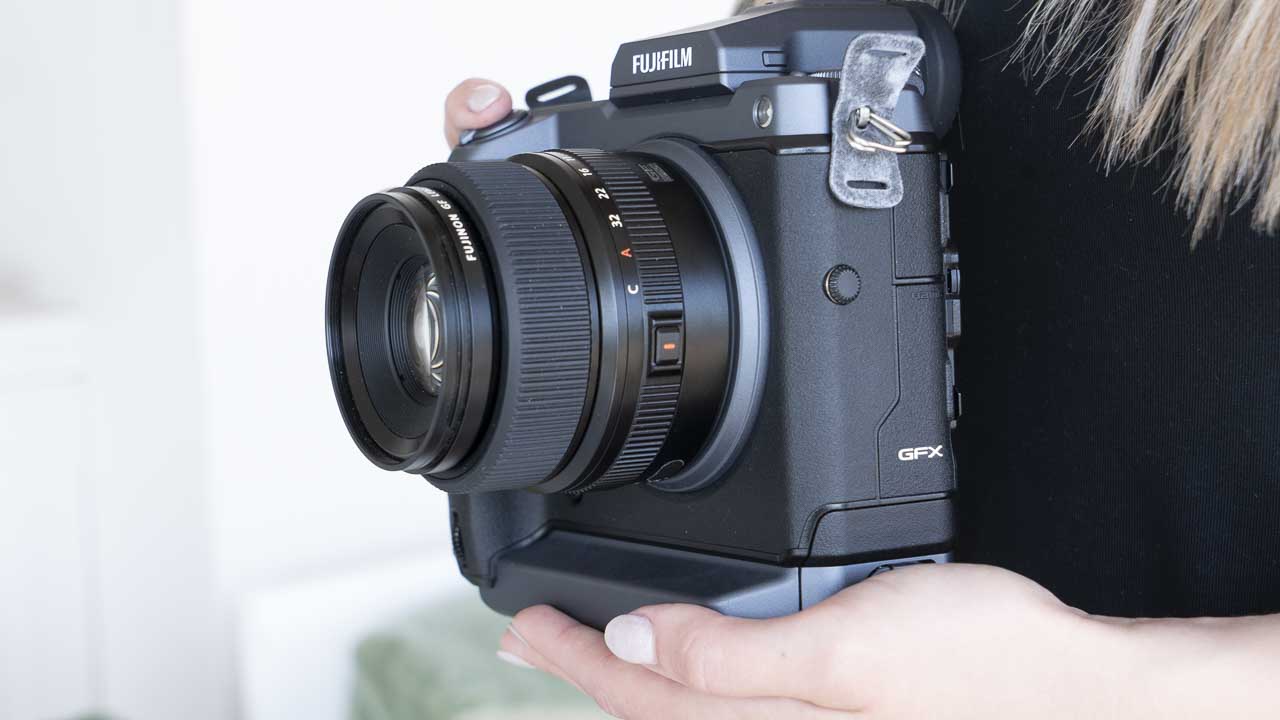
Specification
- Camera type: Medium format mirrorless
- Announced: June 2019
- Phase detection AF points: 3.67m
- Sensor: 102Mp Medium format (43.8 x 32.9mm) CMOS with Bayer colour filter array
- Lens mount: Fujifilm G
- Autofocus system: Intelligent Hybrid AF (contrast AF / phase-detection AF) with up to 425 selectable AF points
- Viewfinder: 0.5-inch 5.76million-dot OLED
- Screen: 3-direction tilting 3.2-inch 2.36million-dot touchscreen
- Continuous Shooting: 10fps for up to 58 Jpeg and 25 raw files with UHS-II card with the viewfinder. In Live view mode, up to 11fps with One-Shot AF or 7fps with Servo AF
- Sensitivity range: Stills: ISO 100-12,800 expandable to ISO 50-102,400, Video: ISO 200-12,800 expandable to 50-25,600
- Max video resolution: 4K (4096×2160) 29.97p / 25p / 24p / 23.98p 400Mbps/200Mbps/100Mbps up to Approx. 60min.
- Storage: SD/SDHC/SDXC UHS-II
- Dimensions: 156.2mm x 163.6mm x102.9mm (inc EVF)
- Weight: 1,400g including EVF, 2x battery & memory card
The Fujifilm GFX100 was Fujifilm’s third digital mirrorless medium format camera and the first to feature a 102Mp sensor. It was also the first-ever medium format camera to feature in-body image stabilisation (IBIS).
Astonishingly, a firmware update introduced Pixel Shift Multi Shot mode which enables the GFX100 to shoot a sequence of 16 images which are then composited into one 400Mp image using Fujifilm’s free Pixel Shift Combiner software to create a 400Mp image.
Although the GFX100’s sensor has a Bayer pattern colour filter array, it otherwise uses the same technology as the sensor in the Fujifilm X-T3. That means it has Fuji’s Intelligent Hybrid AF system that combines contrast detection with phase detection. What’s more, the phase-detection points cover virtually the whole frame and there up to 425 points available for selection.
Like Fujifilm’s X-Series cameras, the Fuji GFX 100 has Single point, Zone AF and Wide/Tracking AF options. In Single Point AF mode the focus point array can be switched between a 13×9 (117) and 25×17 (425) grid of points. There are also 6 sizes of AF point available. Similarly, in Zone AF mode the size of the zone can be changed so it covers 3×3, 5×5 or 7×7 of the 117 areas on a 13×9 grid.
Also, the customisation options that are available in cameras like the X-T3 are available on the GFX 100 in continuous autofocus (AF-C) mode.
In addition, Fujiifilm has improved the Face & Eye detection and tracking. Plus, it’s possible to switch between the detected faces to ensure the right target is used for focusing.
Thanks to the new sensor design and processor, Fujifilm is claiming a 500% improvement in the AF performance in comparison with the GFX 50S.
£9999
$9999.95For
- Stunning images
- Excellent autofocus system
- Superb stabilisation system
Fujifilm GFX100S
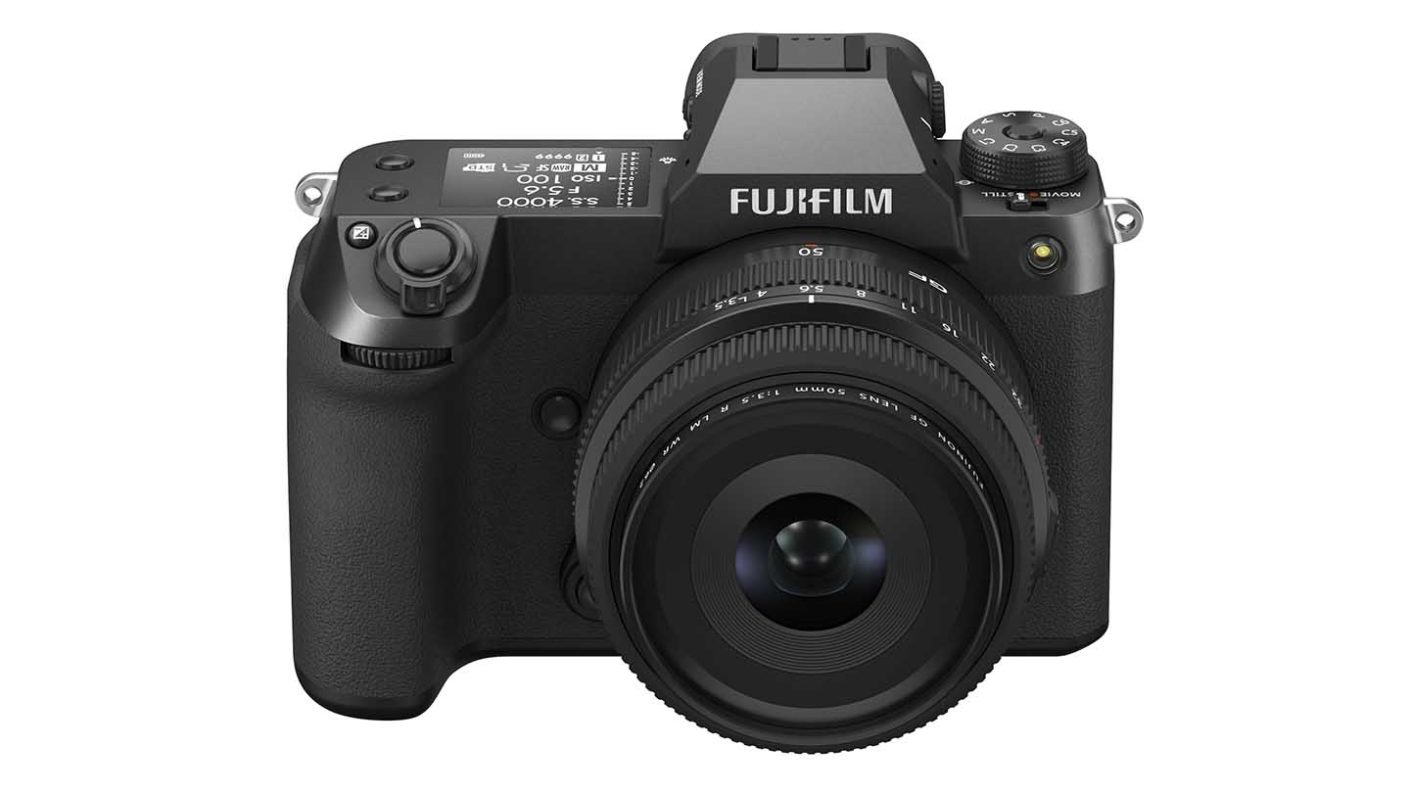
Specification
- Camera type: Medium format mirrorless
- Announced: 27th January 2021
- Sensor: 102Mp Medium format (43.8 x 32.9mm) CMOS with Bayer colour filter array
- Maximum image size: 11648 x 8736
- Processor: X Processor 4
- Lens mount: Fujifilm G
- Autofocusing: Intelligent Hybrid with up to 425 AF points
- Autofocus system: Intelligent Hybrid AF (contrast AF / phase-detection AF) with up to 425 selectable AF points
- Viewfinder: Fixed 0.5-inch 3.69million-dot EVF with 0.77x magnifications 85fps
- Screen: 3-direction tilting 3.2-inch 2.36million-dot touchscreen
- Continuous Shooting: 5fps for 42Jpegs, 16 compressed raw, 15 lossless compressed raw or 14 uncompressed raw
- Sensitivity range: Standard ISO 100-12,800, expandable to ISO 50-102,400
- Image stabilisation: In-body 5-axis giving 6EV compensation, Plus Digital IS and IS Boost for video
- Max video resolution: 4K (4096×2160) 29.97p 400Mbps up to 120min recording, Digital IS (1.1x crop), F-Log, HLG, ProRes Raw (12-bit HDMI)
- Film Simulation Modes: 19 modes: Provia/Standard, Velvia/Vivid, Astia/Soft, Classic Chrome, Pro Neg.Hi, Pro Neg.Std Classic Neg., Nostalgic Neg., Eterna/Cinema, Eterna Beach Bypass, Acros, Acros + Ye Filter, Acros + R Filter, Acros + G Filter, Black & White, Black & White + Ye Filter, Black & White + R Filter, Black & White + G Filter, Sepia
- Storage: SD/SDHC/SDXC UHS-II
- Battery: NP-W325 460 images
- Dimensions: 150 x 104 x 44mm
- Weight: 900g including battery and card
The Fujifilm GFX100S is a medium format camera that doesn’t feel like a medium format camera. With the right lens, it can blend in with full-frame DSLR and mirrorless camera yet it has a sensor that’s 1.7x the size.
It has the same 102Mp back-illuminated CMOS sensor as the Fujifilm GFX100, which means it can produce images that measure 98.62 x 73.96cm or 38.8 x 29.1-inch when printed at 300ppi. And there’s Fujifilm’s Pixel Shift Multi Shot mode that enables it to produce 400Mp images with a little help from a computer running Fujifilm’s Pixel Shift Combiner software.
If you look at images shot at the top native sensitivity setting of ISO 12,800 at 100% on screen, you’ll see a fair amount of luminance noise in the raw files, but as you zoom out, it disappears and there’s a long way to zoom out! Of course it depends what you want to do with your images, the the Fujifilm GFX100S is one of the few cameras that we’d feel reasonably happy about using the upper sensitivity expansions settings.
While the GFX100S’s AF system is a bit fidgety, it’s responsive and can get moving subjects sharp. The Eye AF isn’t the best around, but it’s useful for portraits and the level of detail captured in low to mid-range ISO images is fantastic.
£5499
$5999 / €5999For
- Superb sensor
- Phase detection autofocus system
- Small for medium format
Olympus OM-D E-M5 Mark III
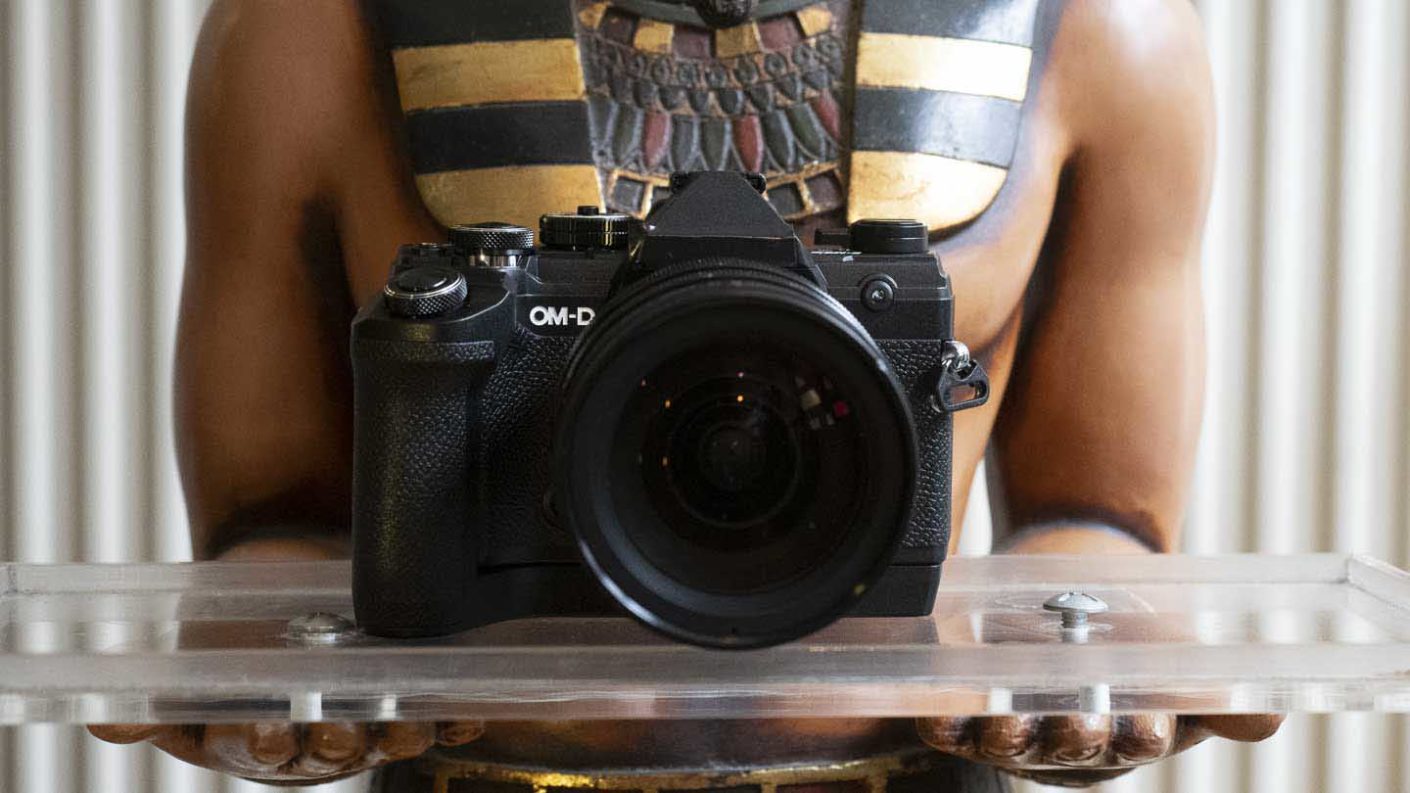
Specification
- Camera type: Mirrorless camera
- Sensor: 20.4Mp Live MOS Micro Four Thirds sensor
- Lens mount: Micro Four Thirds
- Processing engine: TruePic VIII
- Sensitivity range: ISO 64-25,600
- Autofocus system: Hybrid with 121 (all cross-type) phase-detection AF points
- Maximum continuous shooting rate: Mechanical shutter: 10fps with focus and exposure fixed at the start of the burst, 6fps with C-AF, Electronic Shutter 30fps and 10fps
- Max video resolution: C4K 24p at up to 237Mbps / 4K 30p, 25p, 24p at 102Mbps
- Live Bulb Shooting Options: Live Composite, Live Time, Live Bulb, Focus Bracketing, Focus Stacking, 50Mp High Res Shot modes
- Viewfinder: 2,360,000-dot electronic viewfinder
- Screen: Vari‑angle 3.0-inch 1,037,000-dot touchscreen
- Dimensions (W x H x D): 125.3 x 85.2 x 9.7mm
- Weight: 414g including battery and memory card, 366g body only
The Olympus OM-D E-M5 Mark III sits below the OM-D E-M1 Mark III in Olympus’s interchangeable lens camera lineup. It has a smaller body, which makes it a great choice for travel. It also produces nice images and the stabilisation system is incredible, enabling you to hand-hold the camera and get sharp images with exposures measured in whole seconds. In addition, it does a good job with video; although if you’re really serious about shooting moving images you might want to look at the Panasonic Lumix G90 which has a true Log mode.
Olympus has given the E-M5 Mark III the same 20.4Mp Live MOS sensor as the OM-D E-M1 Mark II. The processor is also listed as the same TruePic VIII engine, but Olympus tells us it’s been updated for a bit more oomph.
Like the OM-D E-M1 II, the OM-D E-M5 III has a 121-point (all cross-type) phase-detection autofocus (AF) system. There are also clever shooting options such as Live Composite, Live Time, Live Bulb, Focus Bracketing, Focus Stacking and a 50Mp High Res Shot mode.
As with its predecessor, the OM-D E-M5 II, the High-Res Shot mode is a tripod-only option. When this mode is activated, the E-M5 III shifts the imaging sensor by 0.5-pixel movements between 8 shots. These are then merged into one image that’s equivalent to 50Mp.
Olympus has upgraded the video capability of the OM-D E-M5 Mark III in comparison with the Mark II model. The new camera is capable of shooting C4K 24p video at up to 237Mbps or 4K 30p, 25p, 24p video at 30p 102Mbps.
What’s more, Full-HD video can be shot at up to 120p for slow-motion playback.
Read our buyer’s guide to the best Olympus cameras
£1100
$1199.99For
- Images full of detail
- Low noise at higher ISOs
- Superb stabilisation
Olympus OM-D E-M1X
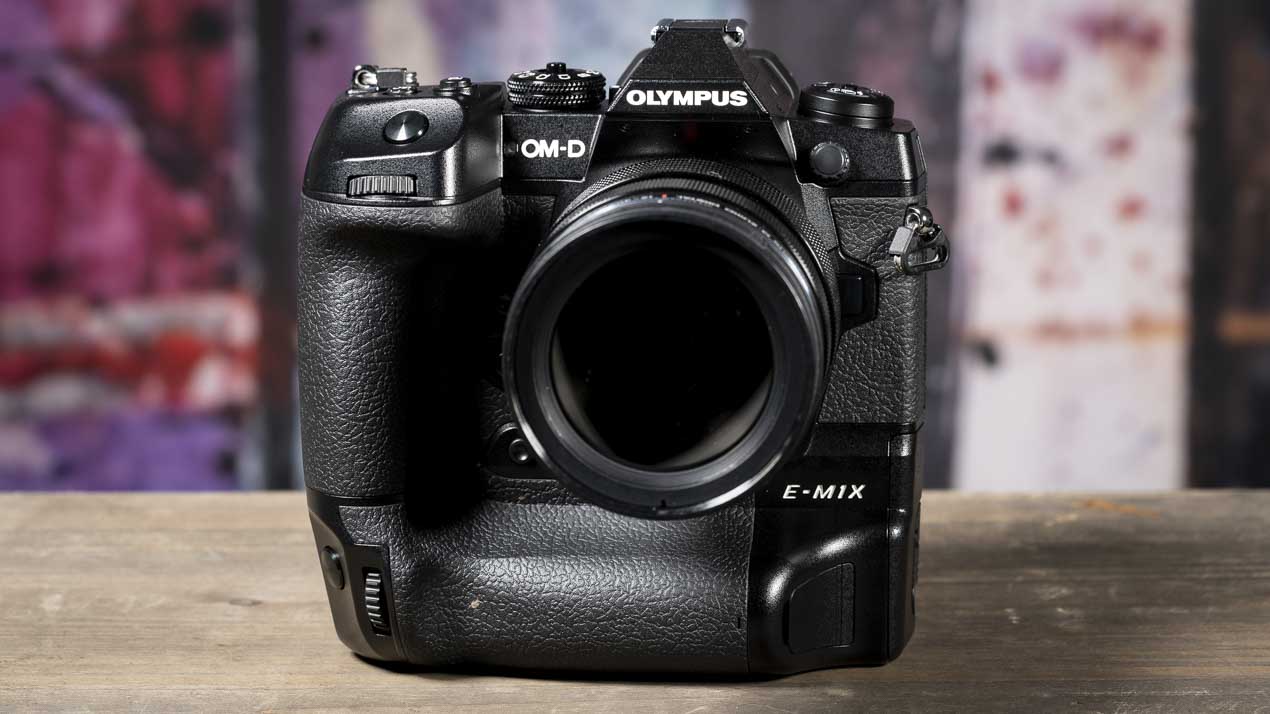
Specification
- Camera type: Mirrorless
- Sensor: 20.4Mp Four Thirds Type (17.3 x 13.0mm) CMOS
- Lens mount: Micro Four Thirds
- Sensitivity range: ISO 64-25,600
- Processing engine: 2x TruePic VIII
- Autofocus system: Hybrid with 121 cross-type points (800 in magnified view)
- Max continuous shooting rate: 18fps with AF tracking, 60fps with AF locked on first frame with electronic shutter
- Pro Capture High Mode: 60fps
- Pro Capture Low Mode: 18fps
- Burst Mode in S-AF: 15fps for 143 raw files
- Burst Mode in C-AF: 10fps for 283 raw files
- Max video resolution: 4K (4096 x 2160) at 24p
- Viewfinder: Electronic with 2,360,000 dots
- Screen: Touch-sensitive vari-angle 3-inch LCD with 1,037,000 dots
- Storage: 2x SD/SDHC/SDXC (UHS-II)
- Dimensions (WxHxD): 144.4 x 146.8 x 75.4mm
- Weight: 849g (body only), 997g (including 2 batteries and memory cards)
The OM-D E-M1X is a doubled-gripped mirrorless camera. It uses Olympus’s Pro Capture mode for shooting stills of very fast action. Thanks to the dual processors, there’s also no blackout in the viewfinder when this is in action.
In Pro Capture High mode, the shooting rate is 60fps, but the focusing is fixed at the start of the sequence. Switch to Pro Capture Low, and you can shoot at 18fps with continuous focusing.
Pro Capture mode is designed to help you record fleeting moments that are easily missed. To that end, when it’s activated the camera starts writing images to the buffer as soon as the shutter release is half-pressed. Once the shutter button is pressed fully, the 35 images that were buffered immediately before it was pressed are recorded along with 100 from immediately after.
There’s also a standard sequential shooting mode that uses the mechanical shutter. When this is in action, the maximum shooting rate in single AF mode is 15fps for 143 raw files. In continuous autofocus mode, the maximum is 10fps for 283 raw files.
A High Res Shot mode also delivers larger and more detailed images. The 50Mp Handheld mode captures the images quickly but then takes a little longer to render the final shot than the Tripod mode. Comparing the results with standard images reveals a nice jump in the level of detail.
Similarly, the 80Mp tripod mode delivers impressive results. It gives a significant boost to the size of print that you can make. That compositing also has a beneficial effect on the dynamic range as there’s more detail visible (and extractable) from the shadows.
£2199
$1999For
- One of the fastest cameras you can buy
- Pro Capture Mode offers lots of flexibility
- High Res Shot mode is very impressive
Olympus OM-D E-M1 Mark II
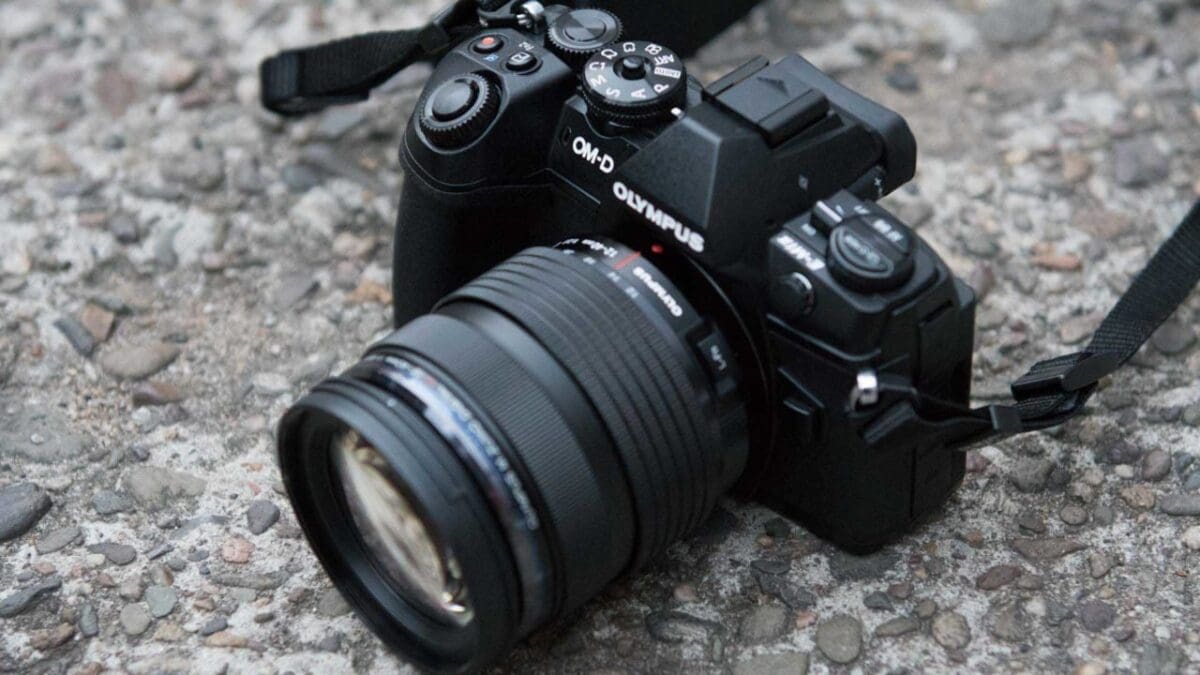
Specification
- Camera type: Mirrorless camera
- Sensor: Four Thirds-type 20.4Mp Live MOS
- Processing engine: TruePic VIII
- Lens mount: Micro Four Thirds
- Autofocus system: Hybrid with 121 all cross-type focusing points
- Max continuous shooting rate: 18fps with AF tracking, 60fps with AF locked on first frame with electronic shutter
- Max video resolution: 4K (4096 x 2160) at 24p
- Viewfinder: 2,360,000-dot electronic viewfinder
- Sensitivity range: ISO 64-25,600
- Screen: Vari‑angle 3-inch 1,037,000-dot touchscreen
- Storage: 2x SD/SDHC/SDXC (UHS-II)
- Dimensions (W x H x D): 134.1 x 90.9 x 68.9mm
- Weight: 498g (body only), 574g (including battery and memory card)
The E-M1 II is a complex and versatile camera. It takes a while to get to discover all its features and understand some of its quirks, but it’s a rewarding experience.
Its stabilisation system is incredible and allows you to rethink how you shoot, leaving the tripod behind and avoiding high ISO settings. Olympus has also packed in the clever technology that we have come to expect with Live Bulb, Live Time and Live Composite mode making long exposure photography easy and in-camera focusing stacking enabling greater depth of field than is normally possible. In addition, High Res Shot mode turns this 20Mp camera into a 50Mp device – and you can use it for normal landscape photography with no concern about a breeze blowing through the trees.
High Res Shot mode has impressed us in the past with its ability to produce larger files with greater detail by combining a sequence of images in-camera. According to Olympus the latest version of the system in the OM-D E-M1 II produces images with resolution equivalent to 50Mp shots. It can also compensate for the slight movement in landscape scenes – leaves and grass etc.
Olympus’s Image Stabiliser (IS) is widely respected, but the latest version in the E-M1 II raised a few eyebrows at the launch event because it’s capable of extending the safe hand-holdable shutter speed by up to 6.5 stops with stabilised lenses like the new Olympus 12-100mm f/4.0 IS Pro. That’s an incredible figure, higher than any other camera. It could produce some interesting creative opportunities that are only normally possible with a tripod.
Further good news is that the Olympus OM-D E-M 1 Mark II is capable of recording 4K footage at up to 30p. Combining this with the claimed IS performance could mean the OM-D E-M1 Mark II prove popular with run-and-gun shooters.
Add in a high-quality viewfinder and a vari-angle touch-screen that helps you shoot from more creative angles and you have a very attractive camera.
£1499
$1299For
- Fast and accurate focusing with moving subjects
- Superb stabilisation system
- Innovative features
Panasonic S1
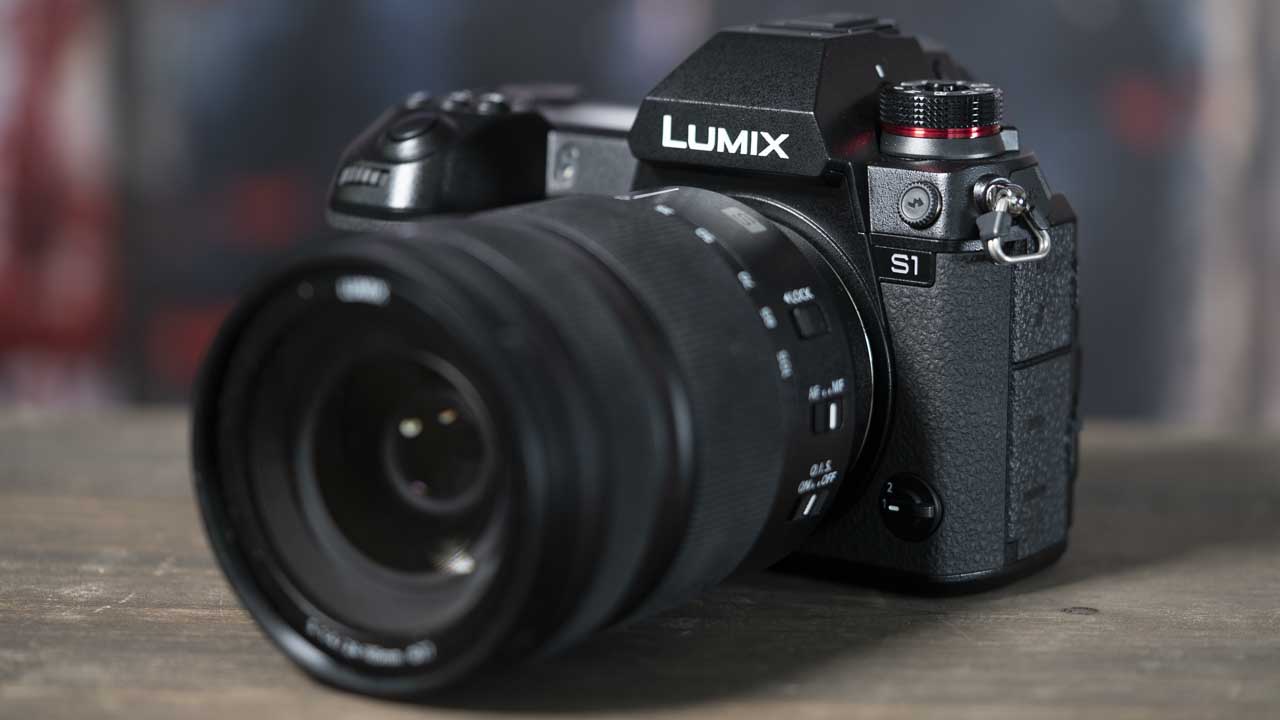
Specification
- Sensor: 24.2MP full-frame (23.8×35.6mm)
- Video: 4K (3840×2160) at 60fps and 150Mbps
- Stabilisation: 5-axis in-body stabilisation
- High Resolution Mode: 96MP (12,000 x 8,000-pixel) images
The Lumix S1 is aimed at professional and high-end enthusiast photographers and videographers. It’s a complex camera that offers lots of opportunities to customise it and make it work for you. It also has a dual-tilting screen, a first-rate viewfinder, excellent video specification, a fast AF system and a useful High Resolution mode that can produce 96Mp images.
Like the Panasonic G9 and S1R, the Lumix S1 has a High Resolution mode. When this is selected, the camera takes a sequence of shots in quick succession with the sensor moving by a tiny amount between each. The S1 then merges the images into a single raw file.
When the aspect ratio is set to 3:2, using High Resolution Mode results in 12,000 x 8,000-pixel images. That’s 96Mp. Thanks to the S1’s IBIS (in-body image stabilisation), its sensor can be moved by a tiny amount between shots in the High Resolution mode. This enables the camera to gather more information about the scene and create larger images.
When the image resolution is set to 300ppi, a standard 24Mp image produces prints that measure 20×13.3inches or 50.8×33.87cm. However, a 96Mp High Resolution mode image would make prints that measure 40×26.6 or 106.6×67.7cm. Each dimension is twice that of the standard image. That’s attractive to landscape, still life, macro and commercial photographers.
There are a few restrictions applied when you use High Resolution mode. For example, it automatically uses the electronic shutter, the minimum aperture is f/16 and the shutter speed can only be set from between 1 and 1/8000 of a second. Sensitivity can be set up to ISO 3200.
It’s the type of camera that takes some getting to know, but it’s also a camera that is worth getting to know.
As the lower-resolution of Panasonic’s two full-frame mirrorless cameras, the Panasonic S1 has a 24.2Mp full-frame sensor. Interestingly, this is a 23.8×35.6mm device whereas the S1R’s sensor is listed as 24x36mm. The total pixel count is 25.28Mp while the effective pixel count is 24.2million.
That sensor has a native aspect ratio of 3:2, but it’s also possible to shoot in 4:3, 1:1, 16: 9, 2:1 and 65:24.
The image sensor is paired with a new Venus Engine processor. This enables a maximum shooting rate of 6fps with continuous autofocusing. If you can do without C-AF, however, the rate can be pushed to 9fps. Alternatively, in 4K/6K Photo mode, it’s possible to shoot 4K images at 60fps or 6K images at 30fps.
Panasonic is aiming the Lumix S1 at creatives who want to be able to shoot both stills and video. On the video front, the headline feature is that the S1 can shoot 4K (3840×2160) at 60fps and 150Mbps. However, if you want to keep the full width of the sensor, the maximum frame rate for 4K video is 30fps.
There’s also an HEVC shooting option at 4:2:0 10-bit for internal recording. This option is missing from the Lumix S1R.
Helpfully, Panasonic’s Dual IS system is incorporated. This stabilises images and video.
In addition, Panasonic is going to introduce an optional (paid for) firmware update for the Lumix S1 to introduce full V-Log recording. This will also enable 4:2:2 10-bit 4K 24p/30p internal video recording and 4:2:2 10-bit 4K 60p HDMI output.
£2200
$2497.99For
- Solid construction
- 4K footage is very impressive
- AF system great at picking out small subjects
Panasonic S1R
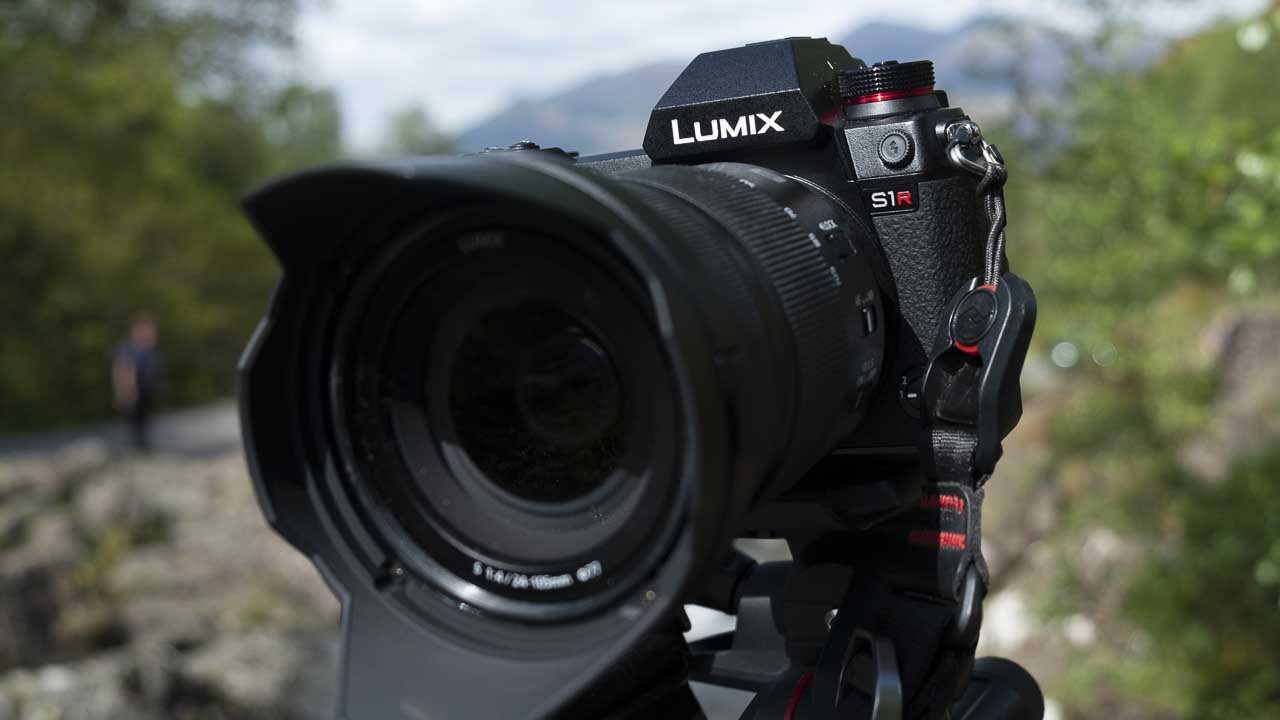
Specification
- Camera type: Full-frame mirrorless
- Announcement: 1st February 2019
- Sensor: 47.3MP full-frame (36x24mm)
- Aspect Ratios: 2:3, 4:3, 1:1, 16:9, 2:1 and 65:24
- Sensitivity range: ISO 100-25,600, expandable to ISO 50-51,200
- Video: 4K (3840×2160) at 60fps and 150Mbps
- 6K Photo / 4K Photo: 6K PHOTO: 30 frames/sec 4K PHOTO: 60 frames/sec, 30 frames/sec, Extracted image format: Jpeg
- Maximum continuous shooting rate: Mechanical shutter: AFS/MF: H: 9 frames/sec, AFC: H: 6 frames/sec , Electronic shutter: AFS/MF: H: 9 frames/sec, AFC: H: 5 frames/sec
- Stabilisation: Dual IS 2 to 7EV compensation
- Viewfinder: 5,760,000-dot OLED
- Screen: 3.2-inch 2,100,000-dot triaxial tilt touchscreen
- Autofocus system: Contrast detection with 225 areas, Auto Detection (Face, Eye, Body, Animal)
- Storage: Dual ports: XQD/CFexpress and SD/SDHX/SDXC UHS-II
- Dimensions (HxWxD): 110x148.9x96.7mm
- Weight: 1016g
The Panasonic S1R has a sensor with an effective pixel count of 47.3 million. Unlike Panasonic’s G-Series Micro Four Thirds cameras which have a native aspect ratio of 4:3, the S1R’s 36x24mm sensor is a 3:2 device. However, there are also aspect ratio settings of 4:3, 1:1, 16:9, 2:1 and 65:24 should you want them.
Given the high pixel count of the Panasonic S1R in comparison with the S1, it’s no surprise to find it has a more limited sensitivity range. The standard range is ISO 100-25,600, and there are expansion settings to take it to ISO 50-51,200. That upper value is the same as the Lumix S1’s highest native setting.
Panasonic is aiming the Lumix S1R at professional photographers who want a high-resolution camera. For many, the 47Mp resolution is likely to be enough, but like the Panasonic S1 and Panasonic G9, the Lumix S1R also has a High Resolution mode.
When this is mode is activated, the camera shoots a series of eight images in quick succession. Using the in-body stabilisation mechanism, it moves the sensor a fraction between each shot. The camera then merges the images to create one much larger raw file.
When the aspect ratio is 3:2, using High Resolution Mode results in 16,736 x 11,186-pixel images. That means the images have 187million pixels! At 300ppi this enables you to create 141.7 x 94.56cm (55.787 x 37.227-inch) prints.
The Lumix S1R is an advanced camera with plenty of customisability and a dual-tilting touchscreen. There’s also a class-leading electronic viewfinder, and a nippy AF system. And, despite the already high pixel count, there’s a High Resolution mode that produces 187Mp images that are superb but challenging for computers.
It’s a complex camera, but well thought out and capable of producing superb results. Also, it sets a new benchmark for electronic viewfinders, with a super-smooth, high-detail view. And while the screen may not flip out for viewing from the front, its robust hinges allow it to tilt horizontally and vertically. This makes it useful for all sorts of photography as well as shooting video.
Naturally, the main reason for investing in a 47Mp camera is to produce images with lots of detail. The Panasonic Lumix S1R certainly delivers on this score. If you want to take things up a notch, there’s the High Resolution mode.
£2899
$3698For
- Robust build
- High-quality high-resolution images
- Excellent handling with lots of customisation
Panasonic Lumix G9

Specification
- Camera type: Micro Four Thirds mirrorless camera
- Sensor: 20.3 million Four Thirds type (17.3 x 13mm)
- Burst Mode: 20fps with AF-C, 60fps with AF-S
- Autofocus: 225-point Contrast detection
- Video: 4K (3840 x 2160) at 60p, 50p, 30p, 25p, 24p with no cropping
- Dimensions (W x H x D) : 136.9 x 97.3 x 91.6 mm / 5.39 x 3.83 x 3.61 inch (excluding protrusions)
- Weight: 658g / 1.45lb including 1 SD card x and battery, 586g / 1.30lb body only
The Panasonic Lumix G9 is Panasonic’s flagship Micro Four Thirds stills-camera and it sits alongside the GH5 at the top of the company’s G-series interchangeable lens camera line-up.
Like the GH5, the G9 is a mirrorless camera with a Four Thirds Type sensor and a Micro Four Thirds lens mount. Panasonic says the camera is aimed at enthusiast outdoor and wildlife photographers.
While the GH5 is largely known as a video camera, it’s also a very capable stills camera. The fact that the Panasonic Lumix G9 has the same sensor and processing engine, but has been tuned for stills rather than video is, therefore, good news for photographers. It also feels like a high-quality camera, being light yet sturdy with a good-sized grip while the touch-control is accompanied by a healthy array of physical controls.
The G9 has the same 20.3Mp sensor and Venus 10 processing engine as the GH5. However, Panasonic tells us the G9’s sensor and processor have been tuned very differently to suit the G9’s stills-shooting focus. To boost detail resolution, the sensor also has no optical low-pass filter.
While 20Mp images will suffice for many situations, the G9 also has a High Resolution mode that enables 80-megapixel images to be created in JPEG and raw formats in-camera. In this mode the camera takes a sequence of 8 images in quick succession, shifting the sensor a little between each shot. These images are then merged to create a single larger image with more detail.
This is a tripod-only mode and it takes approximately 4 seconds to process the image – that’s about half the time that the Olympus OM-D E-M1 Mark II takes in its Pixel Shift mode.
Panasonic has also given the G9 a very high-quality electronic viewfinder, an articulating touch-screen and a blistering continuous shooting rate. Further good news is that the AF system can keep up with the frame rate so you can shoot sport and action.
£1499
$1698 / €1729For
- Compact weather-sealed body
- Stabilisation system rated at 6.5EV
- High-quality EVF and screen
Pentax K-1 II

Specification
- Sensor: 36.4 million Full-frame (35.9 x 24mm)
- Processor: PRIME IV
- Autofocus: 33-points with 25 cross-type
- Sensitivity: ISO 100-240,800
There aren’t a whole lot of differences between the Pentax K-1 II and the K-1, but chief among them was an upgrade to Pentax’s Pixel Shift Resolution System. This is now called Pixel Shift Resolution System II and includes a Dynamic Pixel Shift Resolution mode, which is designed to record better colour and definition.
It works by moving the sensor by a pixel width between each of four shots which are then composited into one image. For the first time there are two modes for this.
The first being the one we have seen before that should only be used when the camera is on a tripod and with a motionless subject. A second new option is able to cope with moving subjects and the camera being hand-held. Pentax still recommends using a tripod for the best results though.
Pentax says Pixel Shift Resolution II obtains RGB colour data for each pixel to produce super-high-resolution images with finer details and more truthful colours than those produced by ordinary full-frame sensors.
In the new Dynamic Pixel Shift Resolution mode, which can be used during handheld shooting, this system can be used jointly with the camera’s shake-reduction mechanism, since it synthesizes the captured super-high-resolution images by detecting the slight fluctuations of the subject’s position during continuous shooting.
The camera also provides ON/OFF switching of the Motion Correction function, which detects moving elements of the continuously captured images to minimize the effect of movement during the image synthesizing process.
£1800
$1999.95For
- Captures superb detail
- Pixel Shift Resolution II
- Excellent colour
- Weather-proof
Pentax KP
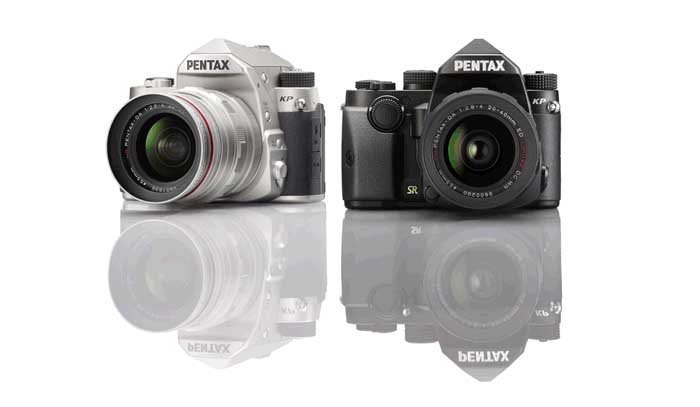
Specification
- Sensor: 24.32 million APS-C CMOS
- Maximum Shutter Speed: 1/6000sec mechanical / 1/24,000sec electronic
- Video: Full HD video at 60i/30p
- Screen: 3in, 921k-dot, tiltable LCD
Inside the Pentax KP is a newly developed APS-C-sized CMOS image sensor with 24.32 million effective pixels, which has no anti-aliasing filter for resolving finer details.
The sensor, in combination with a PRIME IV imaging engine, enables the Pentax KP to shoot night scenes at the super-high sensitivity of ISO 819,200.
The Pentax KP doesn’t offer 4K video recording. However, it does include a 4K Interval Movie mode that stitches together a series of 4K-resolution still images (3840 x 2160 pixels) at a fixed interval to create a single movie file.
Also on-board the Pentax KP is the company’s Pixel Shift Resolution System, as seen in other recent Pentax cameras and similar to what we’ve seen from recent Olympus cameras.
This technology enables the KP to capture four images of the same scene by shifting the image sensor by a single pixel for each image. The KP then stitches them into a single, high-resolution composite image.
Ricoh says that compared to the conventional Bayer system in which each pixel has only a single colour data unit, this new system obtains all colour data in each pixel to deliver ultra high-resolution images with more accurate colours and much finer details than those produced by conventional APS-C-sized image sensors.
Ricoh says it has also added an ON/OFF switch for the motion correction function to make the Pixel Shift system usable with a wider range of subjects. The motion correction system promises to automatically detect a moving object during continuous shooting and minimise negative effects during the synthesising process.
The Pentax KP also has a five-axis SR II shake reduction mechanism that delivers a compensation effect of approximately five shutter steps.
When taking a panning shot, this mechanism controls the SR unit to compensate for all external factors without requiring any switching action.
£1099
For
- Pixel Shift Resolution system
- High sensitivity of ISO 819,200
- 5-axis shake reduction
Sony A7R III

Specification
- Camera Type: Full-frame mirrorless
- Sensor: 42.4MP back-illuminated Exmor R sensor
- Lens mount: Sony FE
- Processing Engine: BIONZ X
- Sensitivity range: ISO 100 – 32000 expandable to ISO 50 – 102400 for still images
- Autofocus system: 824-point Hybrid (399 phase detection points, 425 contrast detection points)
- Viewfinder: 0.5-inch type OLED with 3,686,400 dots
- Screen: Tilting 3-inch 1,440,000-dot TFT LCD touchscreen with White Magic
- Dimensions: 126.9 x 95.6 x 73.7mm
- Weight: 657g / 1lb 7.2 oz with battery and card
The Sony A7R III is aimed at enthusiast and professional photographers. Its high resolution gives it particular appeal to landscape, still-life and commercial photographers.
While it has the same pixel count as its predecessor, the 42.4Mp Sony Alpha A7R III made some major enhancements on the camera it replaced. As well as improve handling, there’s faster shooting, more decisive focusing and better image quality.
Like the A7R II, the A7R III has a back-illuminated Exmor R sensor with 42.4 million effective pixels. This has a gapless microlens design to boost light sensitivity and dynamic range.
Unlike the Mark II, the A7R III’s sensor has a front-end LSI. This, together with the enhanced BIONZ X processing engine, delivers a 1.8x increase in processing speed and a range of performance enhancements. Notably, Sony claims a low sensitivity (ISO) dynamic range of up to 15-stops.
There’s also Sony’s Pixel Shift Multi Shooting mode that shifts the sensor by 1-pixel distance between shots as four images are captured. These files can then be combined into one image made up from 169.6Mp worth of data using Sony’s Imaging Edge software. Follow the link for details of how to use Sony’s Pixel Shift Multi Shooting mode.
The end result is a 42.4Mp file with greater detail and better tonal gradation.
The difference between standard files and Pixel Shift Multi Shot files is quite subtle, but it is apparent at normal viewing sizes as well as 100% on-screen, it could be especially beneficial for large prints or displays. The Pixel Shift Multi Shot files have a little more detail and better colour gradation, which gives them more impact.
More good news for anyone with low-light shooting tendencies is that the Bionz X processing engine has been enhanced. This enables more complex noise reduction algorithms to be applied so that there’s a claimed 1-stop reduction the level of noise in images.
£2199
$3199For
- High-quality full-frame 42Mp sensor
- 10fps continuous shooting
- Silent shutter possible at 10fps
Sony A7R IV

Specification
- Camera type: Full-frame mirrorless
- Announced: 16th July 2019
- Sensor: 61MP BSI full-frame sensor
- Lens mount: Sony FE
- Autofocus system: Hybrid with 567 phase detection + 425 contrast detection AF points
- Continuous Shooting: 10fps burst shooting with full AF / AE Tracking
- Video: 4K video with S-Log2/3, HDR
- Sensitivity range: Still images: ISO 100-32000 (expandable to ISO 50 to ISO 102400) Movies: ISO 100-32000
- Viewfinder: 0.5 type 5,760,000-dot OLED
- Screen: Tilting 3-inch 1,440,000-dot touchscreen
- Storage: 2x SD/SDHC/SDXC UHS-II
- Battery: Rechargeable NP-FZ100 battery supplied, Life Stills: 530 shots (viewfinder) / 670 shots (LCD), Movies: 90mins (viewfinder) / 105mins (LCD)
- Dimensions (WxHxD): 128.9 x 96.4 x 77.5mm
- Weight: 665 g / 1lb 7.5oz with battery and SD card
The Sony A7R Mark IV’s 61-million-pixel 35mm sensor is a world first, which the company says delivers ‘medium format quality’.
The sensor is back-side illuminated, and it provides 15 stops of dynamic range. As well as 61-megapixel images, the Sony A7R Mark IV can also produce images with 26 million pixels in APS-C crop mode.
What’s more, its revampled Pixel Shift Multi-Shooting mode can produce images at 240-megapixel resolution. It does this by capturing 960 megapixels worth of data from 16 images, which it then composites together using Sony’s Imaging Edge software.
The A7R Mark IV boasts 567 phase-detection AF points in full-frame mode, which cover 74% of the frame. In the camera’s APS-C mode it has 325 AF points which then cover nearly the entire frame. There’s also Sony’s excellent AI-driven Real-time Eye AF (for humans and animals ins stills mode) and Real-time Tracking modes, which is invaluable for portrait, wedding, sport, pet and social photography.
Depsite its high resolution, the Sony A7R IV is also built for speed and can capture full-resolution 61-megapixel images in continuous shooting mode at up to 10fps, and up to 68 images per continuous burst.
Also among its key features is 5.5-stop, 5-axis in-body image stabilisation, wireless tethering capability, faster USB connection, 802.11ac Wi-Fi plus Bluetooth and studio lighting support.
It all adds up to make the Sony A7R IV one of the best cameras available right now.
Find the best deals on the Sony A7R IV at Amazon UK and Amazon US.
£3500
$3500For
- Superb detail resolution
- Excellent autofocus system
- High-resolution electronic viewfinder
Sony A1
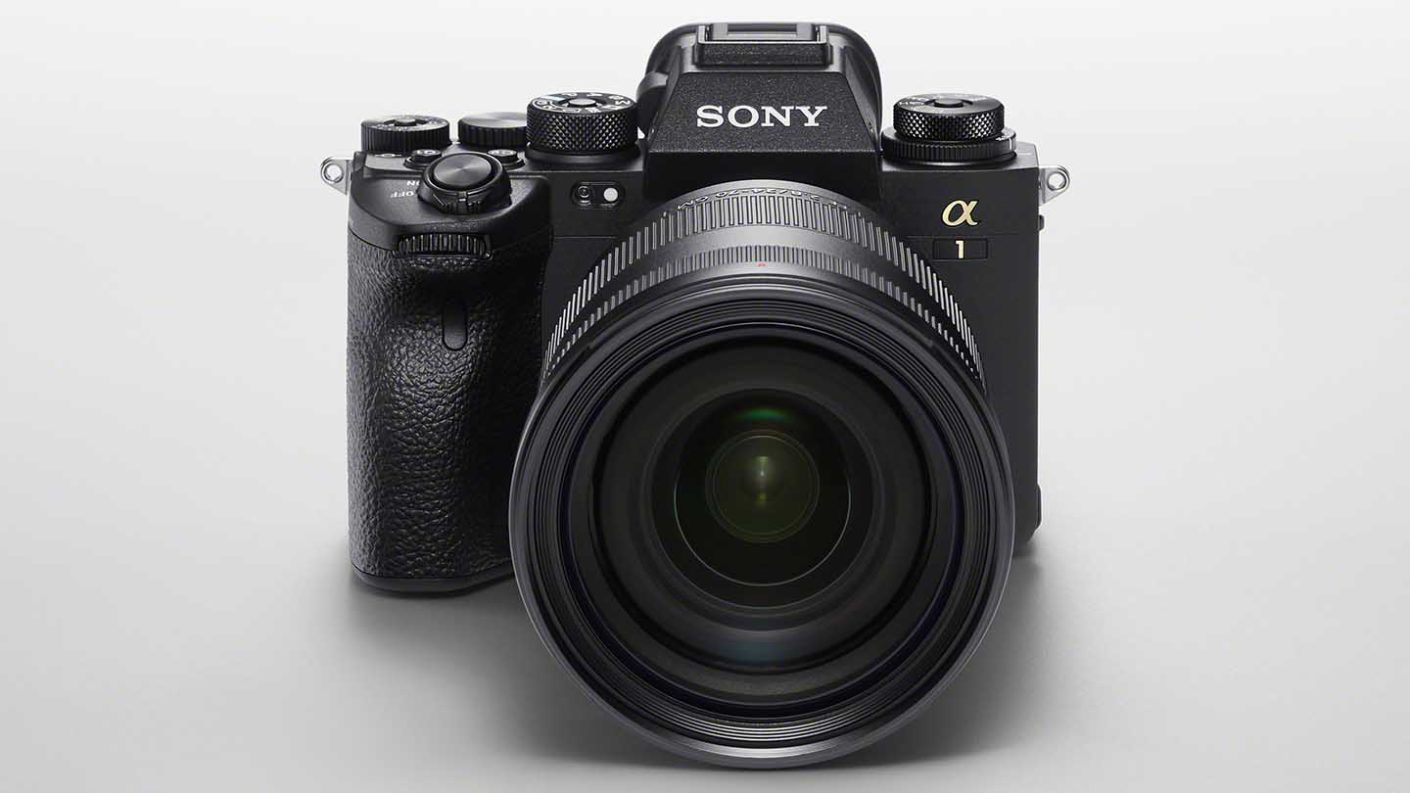
Specification
- Camera type: Full-frame mirrorless
- Announced: 26th January 2021
- Sensor: 50.1Mp full frame (35.9 x 24.0mm), Exmor RS CMOS sensor
- Lens mount: FE
- Sensitivity range: Stills: ISO 100-32000 (expandable to ISO 50 to ISO 102400) Video: ISO ISO 100-32000 (expandable to ISO 100-12800)
- Still Image format: Jpeg, HEIF, raw (Sony ARW 4.0)
- Video format & compression: XAVC S: MPEG-4 AVC/H.264, XAVC HS: MPEG-H HEVC/H.265
- 8K Video (XAVC HS): 7680 x 4320 (4:2:0, 10bit, NTSC) (Approx.): 30p(400Mbps / 200 Mbps), 24p(400Mbps / 200 Mbps), 7680 x 4320 (4:2:0, 10bit, PAL) (Approx.): 25p(400Mbps / 200 Mbps)
- 4K Video (XAVC HS): 3840 x 2160 (4:2:0, 10bit, NTSC) (Approx.): 120p (200Mbps), 60p (150Mbps / 75Mbps / 45Mbps), 24p (100Mbps / 50Mbps / 30Mbps); 3840 x 2160 (4:2:0, 10bit, PAL) (Approx.): 100p (200Mbps), 50p (150Mbps / 75Mbps / 45Mbps); 3840 x 2160 (4:2:2, 10bit, NTSC) (Approx.): 120p (280Mbps), 60p (200Mbps / 100Mbps), 24p (100Mbps / 50Mbps); 3840 x 2160 (4:2:2, 10bit, PAL) (Approx.): 100p (280Mbps), 50p (200Mbps / 100Mbps)
- 4K Video (XAVC S): 3840 x 2160 (4:2:0, 8bit, NTSC) (Approx.): 120p (200Mbps), 60p (150Mbps), 30p (100Mbps / 60Mbps), 24p (100Mbps / 60Mbps); 3840 x 2160 (4:2:0, 8bit, PAL) (Approx.): 100p (200Mbps), 50p (150Mbps), 25p (100Mbps / 60Mbps); 3840 x 2160 (4:2:2, 10bit, NTSC) (Approx.): 120p (280Mbps), 60p (200Mbps), 30p (140Mbps), 24p (100Mbps); 3840 x 2160 (4:2:2, 10bit, PAL) (Approx.): 100p (280Mbps), 50p (200Mbps), 25p (140Mbps)
- 4K Video (XAVC S-I): 3840 x 2160 (4:2:2, 10bit, NTSC) (Approx.): 60p (600Mbps), 30p (300Mbps), 24p (240Mbps); 3840 x 2160 (4:2:2, 10bit, PAL) (Approx.): 50p (500Mbps), 25p (250Mbps)
- Movie functions: Audio Level Display, Audio Rec Level, PAL/NTSC Selector, Proxy Recording (1280 x 720 (6Mbps), 1920 x 1080(9Mbps), 1920 x 1080(16Mbps)), TC/UB, Auto Slow Shutter, Gamma Disp. Assist, raw output(HDMI)
- Autofocus system: Hybrid AF with 759 phase detection points and 425 contrast detection points, Still images: Human (Right/Left Eye Select) / Animal (Right/Left Eye Select) / Bird, Movie: Human (Right/Left Eye Select), sensitive down to -4EV
- Maximum continuous shooting rate: Mechanical shutter: 10fps, Electronic shutter 30fps
- Viewfinder: 0.64-inch 9,437,184-dot EVF with 100% coverage and up to 0.9x magnification. It also offers 0.90x viewfinder magnification, 41° diagonal field of view with 25mm-high eyepoint
- Screen: 3-inch 1,440,000-dot tilting touchscreen
- Stills shutter speed range: Mechanical shutter: 1/8000-30sec plus Bulb, Electronic shutter: 1/32000-30sec plus Bulb
- Max flash sync speed (full-frame): Mechanical shutter: 1/400 sec, Electronic shutter: 1/200 sec
- Image stabilisation: 5-axis giving up to 5.5EV compensation
- Storage: Dual SD/SDHC/SDXC (UHS-I/II) & CFexpress Type A slots
- Connection ports: Sync, 3.5mm headphone, 3.5mm mic, LAN
- Battery: NP-FZ100 rechargeable Li-ion battery giving 400 shots with the viewfinder or 530 with the screen
- Dimensions (WxHxD): 128.9 x 96.9 x 80.8mm / 5 1/8 x 3 7/8 x 3 1/4 inches
- Weight (including battery & memory card): 737g / 1 lb 10.0 oz
The Alpha A1 is Sony’s most advanced camera to date, it combines a high-resolution full-frame sensor with high-speed performance. It features a new 50.1Mp full-frame stacked Exmor RS image sensor and can perform up to 120 AF/AE calculations per second.
Thanks to its impressive processing power, the Sony A1 can shoot at up to 30fps (frames per second) while its large buffer allows for sequences of up to 155 full-frame compressed RAW images or 165 full-frame JPEGs to be shot at that rate.
In addition to improved Real-time Eye AF for humans and animals, the Alpha 1 uses high-level subject recognition technology for Real-time Eye AF for birds. Algorithms also maintain the AF tracking if a sitting bird takes off or the framing changes.
The Sony A1 is the first Sony Alpha series camera to feature 8K 30p 10-bit 4:2:0 XAVC HS video recording. It’s also capable of shooting 4K 120p / 60p 10-bit 4:2:2 video and offers S-Cinetone colour. It uses 8.6K oversampling for enhanced resolution and, naturally, the 8K footage can be used for 4K editing during post-production.
The Sony A 1 has a 9.44 million dot OLED Quad-XGA electronic viewfinder, with a refresh rate of up to 240 fps, ensuring no blackout, delivering the highest resolution in its class. In addition, there’s a 3-inch 1,440,000-dot tilting touchscreen that features the revised menu arrangement and more extensive touch-control that was first seen in the Sony A7S III.
In case a resolution of 50Mp isn’t enough, the Sony A1 has Sony’s Pixel Shift Multi Shooting mode onboard to enables 16 full-resolution images to be composited.
You can order the Sony A1 from Wex Photo Video and Park Cameras in the UK and Adorama or B&H Photo Video in the USA. You can also find the latest Sony A1 offers at Amazon UK and Amazon US.
£6500
$6500For
- Excellent combination of speed and resolution
- Great range of video features including 8K video
- Superb electronic viewfinder


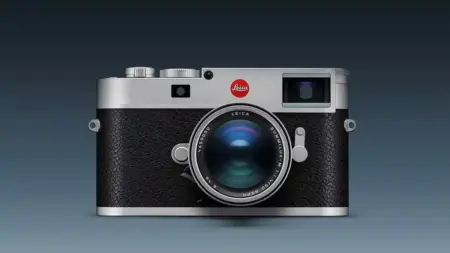

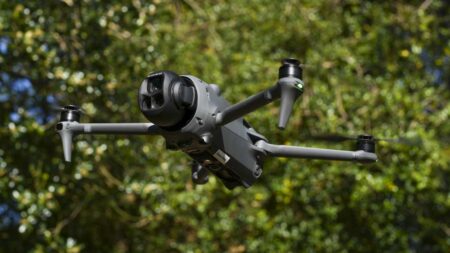
Leave a Reply